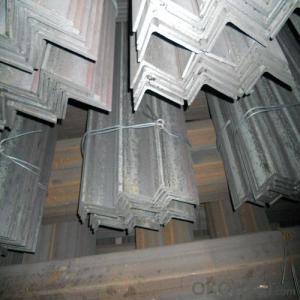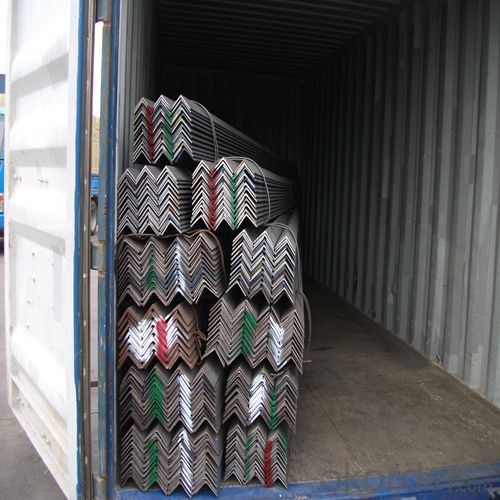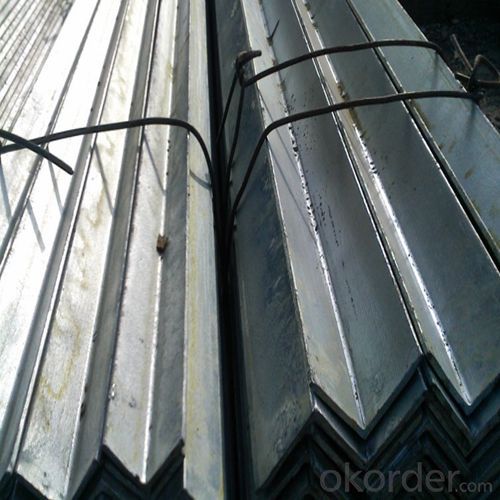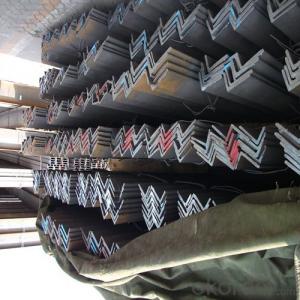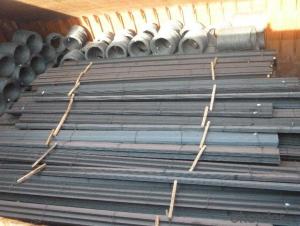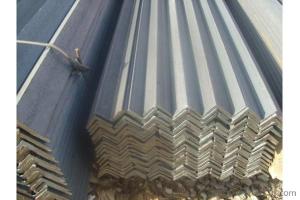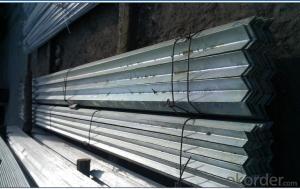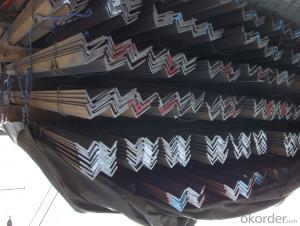HOT ROLLED STEEL ENGLE BAR EQUAL ENGLE BAR UNEQUAL BAR
- Loading Port:
- Tianjin
- Payment Terms:
- TT OR LC
- Min Order Qty:
- 50 m.t.
- Supply Capability:
- 20000 m.t./month
OKorder Service Pledge
OKorder Financial Service
You Might Also Like
Product Description:
Specifications of Angle Steel
1. Invoicing on theoretical weight or actual weight as customer request
2. Length: 6m, 9m, 12m as following table
3. Sizes
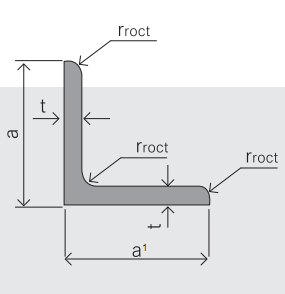
Sizes: 25mm-250mm | ||
a*t | ||
25*2.5-4.0 | 70*6.0-9.0 | 130*9.0-15 |
30*2.5-6.6 | 75*6.0-9.0 | 140*10-14 |
36*3.0-5.0 | 80*5.0-10 | 150*10-20 |
38*2.3-6.0 | 90*7.0-10 | 160*10-16 |
40*3.0-5.0 | 100*6.0-12 | 175*12-15 |
45*4.0-6.0 | 110*8.0-10 | 180*12-18 |
50*4.0-6.0 | 120*6.0-15 | 200*14-25 |
60*4.0-8.0 | 125*8.0-14 | 250*25 |
5. Payment terms:
1).100% irrevocable L/C at sight.
2).30% T/T prepaid and the balance against the copy of B/L.
3).30% T/T prepaid and the balance against L/C
6.Material details:
Alloy No | Grade | Element (%) | |||||
C | Mn | S | P | Si | |||
|
|
|
|
|
|
| |
Q235 | B | 0.12—0.20 | 0.3—0.7 | ≤0.045 | ≤0.045 | ≤0.3 | |
|
|
|
|
|
|
| |
Alloy No | Grade | Yielding strength point( Mpa) | |||||
Thickness (mm) | |||||||
≤16 | >16--40 | >40--60 | >60--100 | ||||
≥ | |||||||
|
|
|
|
|
| ||
Q235 | B | 235 | 225 | 215 | 205 | ||
Alloy No | Grade | Tensile strength (Mpa) | Elongation after fracture (%) | ||||
Thickness (mm) | |||||||
| ≤16 | >16--40 | >40--60 | >60--100 | |||
≥ | |||||||
|
|
|
|
|
|
| |
Q235 | B | 375--500 | 26 | 25 | 24 | 23 | |
Usage & Applications of Angle Steel
According to the needs of different structures, Angle can compose to different force support component, and also can be the connections between components. It is widely used in various building structures and engineering structures such as roof beams, bridges, transmission towers, hoisting machinery and transport machinery, ships, industrial furnaces, reaction tower, container frame and warehouse etc.
Packaging & Delivery of Angle Steel
1. Packing: it is nude packed in bundles by steel wire rod
2. Bundle weight: not more than 3.5MT for bulk vessel; less than 3 MT for container load
3. Marks:
Color marking: There will be color marking on both end of the bundle for the cargo delivered by bulk vessel. That makes it easily to distinguish at the destination port.
Tag mark: there will be tag mark tied up on the bundles. The information usually including supplier logo and name, product name, made in China, shipping marks and other information request by the customer.
If loading by container the marking is not needed, but we will prepare it as customer request.
Production flow of Angle Steel
Material prepare (billet) —heat up—rough rolling—precision rolling—cooling—packing—storage and transportation
- Q: What are the welding techniques used for steel angles?
- Some common welding techniques used for steel angles include shielded metal arc welding (SMAW), gas metal arc welding (GMAW), and flux-cored arc welding (FCAW). These techniques are effective in joining steel angles due to their ability to provide strong and durable welds.
- Q: Can steel angles be used for supports in bridges?
- Steel angles can indeed be utilized as supports in bridges. These angles are frequently employed in bridge construction due to their capacity to provide both strength and stability. They serve as vertical supports, known as piers or columns, as well as horizontal supports, referred to as beams or girders. The usage of steel angles in bridge construction offers numerous benefits. These include their exceptional strength-to-weight ratio and their ability to endure substantial loads and vibrations. Moreover, steel angles are highly adaptable and can be easily fabricated and connected, resulting in efficient and cost-effective bridge construction. All in all, due to their enduring nature, dependability, and efficiency in supporting the weight and load of a bridge structure, steel angles are widely favored as a choice for bridge supports.
- Q: Can steel angles be used for framing or supporting suspended ceilings?
- Steel angles, known for their strength and durability, are frequently employed in construction to offer structural support and stability. They are ideal for framing and supporting suspended ceilings. By affixing steel angles to walls or ceilings, a framework for the suspended ceiling system can be established. Complementing materials like hangers, wires, and channels are often used in conjunction with steel angles to ensure a secure and stable structure for the suspended ceiling. Furthermore, steel angles can be customized and cut to precise lengths and sizes, enabling their versatility in a wide range of framing and supporting applications.
- Q: Can steel angles be used for decorative purposes?
- Yes, steel angles can definitely be used for decorative purposes. They can be shaped and designed in various ways to add a modern and industrial touch to interior or exterior spaces. Steel angles can be used as decorative accents, such as in furniture design, architectural details, or even as standalone decorative pieces. Their durability and versatility make them an excellent choice for adding a unique and stylish element to any space.
- Q: Can steel angles be used for sign or billboard support structures?
- Yes, steel angles can be used for sign or billboard support structures. Steel angles are commonly utilized in construction for their strength, durability, and versatility. They provide a sturdy framework and can be easily welded or bolted together, making them suitable for supporting signs or billboards of various sizes and weights.
- Q: What's the chemical reaction between stainless steel and galvanized angle iron?
- They are not the two reaction, after they are Unicom, there can be electronic flow, and zinc than iron lively, so galvanized angle iron is more likely to be corrosion (mainly air oxidation).
- Q: What are the different methods of connecting steel angles to other structural elements?
- There are several methods for connecting steel angles to other structural elements. Some common methods include bolting, welding, and using angle connectors or brackets. Bolting involves using bolts and nuts to secure the steel angles to the other elements. Welding involves fusing the steel angles with the other elements using heat and filler material. Angle connectors or brackets are specifically designed connectors that provide a secure and rigid connection between the steel angles and other structural elements. These methods vary in terms of their complexity, cost, and structural stability, and the choice of method depends on factors such as the load requirements and design specifications of the structure.
- Q: How do steel angles compare to other structural shapes like beams and channels?
- Construction and engineering projects often utilize steel angles, beams, and channels as structural shapes. These shapes each possess distinct characteristics and advantages, but steel angles specifically offer unique benefits that contribute to their popularity. The versatility of steel angles is a key advantage. They can be employed in various applications, such as supporting heavy loads, bracing structures, and creating frameworks. With their L-shaped design, steel angles can be easily joined together through welding or bolting to construct larger structures or frameworks. In terms of cost-effectiveness, steel angles tend to be more economical compared to steel beams. They require less material for manufacturing, making them a more budget-friendly option for projects with financial constraints. Furthermore, steel angles are typically lighter in weight than beams, which can be advantageous for transportation and installation expenses. On the other hand, steel channels provide similar benefits to steel angles but possess a distinct shape. Channels possess a U-shaped design, offering enhanced stability and support. They are commonly utilized in applications that demand increased strength, such as the construction of bridges, buildings, and machinery. While steel angles may not offer the same level of strength and load-bearing capacity as steel beams or channels, they remain a reliable choice for numerous structural applications. Their versatility, cost-effectiveness, and ease of installation make them a preferred option for a broad range of construction and engineering projects.
- Q: How do you prevent corrosion on steel angles?
- One effective method to prevent corrosion on steel angles is by applying a protective coating such as paint or zinc. This barrier creates a physical barrier between the steel and the corrosive elements in the environment, preventing direct contact and reducing the chances of corrosion. Regular maintenance and inspection, along with promptly addressing any signs of damage or rust, can also help prevent corrosion on steel angles.
- Q: What are the different types of connections used for steel angles in marine applications?
- In marine applications, steel angles are commonly used to provide structural support and reinforcement. These angles are connected using various types of connections to ensure their stability and strength in the harsh marine environment. Some of the different types of connections used for steel angles in marine applications include: 1. Welded Connections: Welding is one of the most common methods used to connect steel angles in marine applications. It involves joining the angles by melting the base metals and then allowing them to cool and solidify. Welded connections provide excellent strength and durability, making them suitable for heavy-duty marine applications. 2. Bolted Connections: Bolted connections are another commonly used method for connecting steel angles in marine applications. This involves using bolts, nuts, and washers to secure the angles together. Bolted connections offer ease of installation and allow for disassembly if required. They are also suitable for situations where the angles need to be adjusted or replaced. 3. Riveted Connections: Riveting is an older method of connecting steel angles that is still used in some marine applications. It involves using a rivet—a metal pin with a head on one end—to connect the angles. The rivet is inserted through pre-drilled holes in the angles and then deformed to secure them together. Riveted connections offer good strength and resistance to vibration, but they can be more time-consuming to install compared to other methods. 4. Adhesive Connections: Adhesive bonding is a modern method used for connecting steel angles in marine applications. It involves using high-strength adhesives to join the angles together. Adhesive connections offer the advantage of distributing stress evenly across the connected surfaces and eliminating the need for drilling or welding. However, they may require careful surface preparation and curing time to achieve optimal strength. 5. Hybrid Connections: In some cases, a combination of different connection methods may be used for steel angles in marine applications. For example, a welded-bolted connection may be employed to provide additional strength and redundancy. Hybrid connections offer the benefits of multiple connection methods while ensuring a robust and reliable connection. The choice of connection type for steel angles in marine applications depends on various factors such as the load requirements, environmental conditions, and project specifications. It is essential to consider the specific needs of the application and consult with structural engineers and marine professionals to determine the most suitable connection method.
Send your message to us
HOT ROLLED STEEL ENGLE BAR EQUAL ENGLE BAR UNEQUAL BAR
- Loading Port:
- Tianjin
- Payment Terms:
- TT OR LC
- Min Order Qty:
- 50 m.t.
- Supply Capability:
- 20000 m.t./month
OKorder Service Pledge
OKorder Financial Service
Similar products
Hot products
Hot Searches
Related keywords
